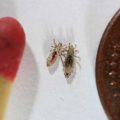Scabies is a common skin condition caused by tiny insects called itch mites. As a matter of fact, millions of cases of scabies infection are being recorded each year worldwide. These eight-legged tiny crawlers are so small they’re almost invisible to the naked eye and can’t be seen on skin. People know they have scabies when the top layer of the skin shows the symptoms of the infection, as the mites live, feed and breed on the top layer of the skin. The skin shows signs of symptoms through rashes and sores caused by scratches, as the skin becomes extremely itchy when it reacts to the mites.
Scabies Is Contagious
The thing about these mites is that, they can be contagious, and can travel from one person to another. Most gets scabies infection through direct contact of an infected person, usually skin-to-skin, such as sexual contact. Though rare, they can be transmitted through contact with infested items, such as clothing, bedding, furniture, etc. Also, they may survive without a human host for about 2 to 3 days.
Also, anyone can get scabies infection. It affects people of all ages, sex, race, etc. Even those who are always clean can get them. They usually spread easily in extended-care facilities and nursing homes. Fortunately though, scabies infection is easy to diagnose and treat.
How Symptoms Start
Symptoms don’t automatically show up after first initial contact with an infected person. The mite burrows and setts into the skin. Those who have had scabies before will experience itching 1 to 4 days after first contact with an infected person. Those who have not had scabies before usually takes more days to develop a skin reaction from the mite, symptoms show up after around 2 to 6 weeks.
Signs and Symptoms of Scabies Infection
Itching – Itching (that gets worse at night) is the most common symptom. Itching can be so severe that it’s hard to sleep at night.
Tiny Blisters, Bumps and Rashes – Scabies rash characterized by bumps that forms lines and looks like pimples or hives are caused by bites of the tiny skin crawlers. Some may even develop scaly patches very similar to eczema.
Sores – Scratching this itchy skin infection is extremely hard to resist, which obviously leads to sores.
Crusts on Skin – In severe cases, scabies leads to crusts on skin. This is usually a sign that there’s already around 100 to 1000 mites (and their eggs) burrowing in the skin, and itching and rashes becomes more severe.
These burrows usually appear in folds of the skin. And though they may affect any part of the body, in adults, they usually appear in:
– Armpits
– Between fingers
– On the wrist
– Inner elbow
– Around the breasts
– Around male’s private parts
– On soles of the feet
– Knees
– Buttocks
– Shoulders
In young children and infants, scabies infection usually appears in:
– Face
– Scalp
– Neck
– Palms of hands and soles of the feet
When to Seek Medical Attention
It is important to see your doctor as soon as you realize you have the signs and symptoms that may indicate scabies infection.
Remember though that you should NOT jump into conclusions and self-diagnose yourself. Many skin conditions have similar symptoms, such as dermatitis and eczema. This is why it is always important to seek medical attention, as only the doctors can give you the right diagnosis.






 I love to write medical education books. My books are written for everyone in an easy to read and understandable style.
I love to write medical education books. My books are written for everyone in an easy to read and understandable style.